 This article primarily deals with shutting down an electric water heater. Failure to follow the proper steps may result in damage to the internal elements of the water tank. There are only a handful of steps and they are easy to follow.
This article primarily deals with shutting down an electric water heater. Failure to follow the proper steps may result in damage to the internal elements of the water tank. There are only a handful of steps and they are easy to follow.
In most homes you have one of two types of water heaters, gas and electric. See the section below that explains how to identify what type of water heater you have. For the purposes of this discussion, propane would also be considered gas.
If you have an electric hot water heater, see the article 'How To Shut Down an Electric Hot Water Heater' for instructions on this type of unit. Got other issues that you need to address?
There are two steps in shutting down an electric hot water tank. First you want to shut down the power. Never attempt any repair on an electric hot water heater without turning off the power. Even removing the inspection covers can be dangerous.
Not sure if this is your problem? See the articles 'Electric Water Heater Troubleshooting' and 'Troubleshooting Gas Water Heaters' for a complete listing of all the water heater topics.
Identifying Water Heater Types
How To Identify an Electric Water Heater
Electric Water Heater Power Supply
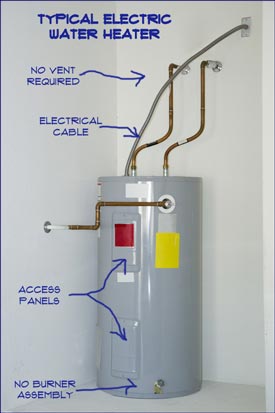 The first and perhaps easiest way to identify an electric water heater is the electrical cable that comes into the top of the tank. This cable could be a metal conduit, a flexible metal cable or even a plastic sheathed romex. Most of the time, this cable will come into the top of the unit, but it is possible for it to come into the side of the water heater.
The first and perhaps easiest way to identify an electric water heater is the electrical cable that comes into the top of the tank. This cable could be a metal conduit, a flexible metal cable or even a plastic sheathed romex. Most of the time, this cable will come into the top of the unit, but it is possible for it to come into the side of the water heater.
This is not to say that there are no types of gas water heaters that have electrical connections. Models with power vents will have an electrical connection. These are more expensive models and less common.
Lack of a Vent
Electric hot water heaters do not have vents. Vents are required on gas water heaters to remove toxic fumes. Electric water heaters do not generate fumes and therefore do not have a vent.
Vents can be made of metal or plastic and usually go into a chimney, metal vent pipe or through an outside wall. An electric water heater will only have the water inlets and a power cable at the top of the unit. NO VENT will be present.
Upper and Lower Access Panels
Electric hot water heaters use heating elements to heat the water. Most of them have two elements, an upper and a lower element. The elements are behind access panels on the side of the water heater. The spacing of these panels will vary, but usually one is near the bottom and the other can be anywhere from the middle of the water heater to near the top.
The panels may be a different color or the same color as the rest of the water heater housing. They are generally held in place by two screws and are easily removed.
A gas water will have a gas valve and burner access panel at the bottom of the water tank only. There will not be any access panels higher up on the housing.
No Gas Burner
An electric hot water heater uses internal heating elements and does not require a burner assembly. On a gas water heater the burner assembly is prominent at the bottom of the hot water heater
Not sure which kind you have? There are a couple of telltale signs that make it easy to identify which style you have. For an electric water heater, the wiring coming into the top of the water heater gives it away. Also, electric water heaters do not have vents, since they do not burn anything to heat up.
A gas water heater is identified by the vent at the top. This can be metal or plastic, depending on the efficiency level of your hot water heater. A gas water heater also has a gas line that attaches to the unit near the bottom.
No Gas Lines
An electric water heater will not have a gas line attached to the water heater. Gas lines are fairly heavy pipes that have large fittings on them. It is called black pipe, since it is black and oily when it is manufactured. The gas line connects at the bottom of the water tank at the gas valve. You will not see any of this on an electric water heater.
How To Identify a Gas Hot Water Heater
Burner Assembly
A telltale sign of a gas water heater is the gas valve and burner assembly at the bottom of the water heater. The gas valve will have a heavy metal gas pip attached to it. It will have a burner assembly below it that will be covered by a removable plate. This plate will protrude around the lower gas line and thermocouple connector.
It is usually possible to see a pilot light through a window after the outer cover plate is removed. Gas water heaters use a burner that has an open flame to heat the water.
Fume Vent at Top
Gas hot water heaters burn natural (or propane) gas to heat the water. Burning fossil fuel produces harmful gases. Therefore, a gas hot water heater will always have a vent of some kind.
The type of vent depends on the efficiency of the hot water heater. Higher efficiency units will use a plastic pipe the vent through an outside wall. Lower efficiency unit will vent into a masonry or metal chimney. Electric water heaters will not have any type of venting apparatus.
Gas Lines
Of course it stands to reason that that a gas hot water heater would use natural or propane gas to operate. This type of gas is a low pressure fuel that requires a fairly large piping system for delivery.
The burner assembly mentioned above will need piping connected to it. This piping will be obvious when you look at the water heater. It will be attached to the gas valve at the bottom of the unit and usually be connected on the left side when you are facing the water heater.
Shutting Down an Electric Water Heater
There are five steps to properly shutting down an electric hot water heater:
(1) Shut off the power to the water heater.
(2) Tag the breaker so that no one turns the power back on while you are working on the water heater.
(3) Cool down the water inside of the tank.
(4) Shut off the cold water supply to the hot water tank.
(5) Open a hot water faucet somewhere, (preferably above) in the house.
Step One - Turning Off a Water Heater Breaker
Most water heaters will have a two pole breaker. This breaker should be marked in your panel. It will usually be between 30 and 50 amps.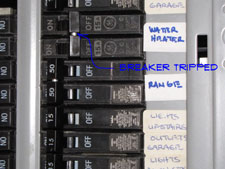
Turn off the power at the breaker panel. Don't be satisfied with just shutting it off. If you have lock out lugs for your breakers, you can put one on it.
Another option would be to tape it and mark the tape so that no one turns it back on. As a further precaution you can let everyone in the house no you are working on the electric. Tell them not to touch the service panel.
One final check. Use a voltage tester (a non contact voltage tester will work good) to make sure nothing is hot inside the covers when you open them up. It is not worth getting shocked or hurt when you are replacing a hot water heater element.
WARNING!! Make Sure the Power is OFF!!! BEFORE You Work on Electrical Devices!!!
Step Two - Tag the Breaker
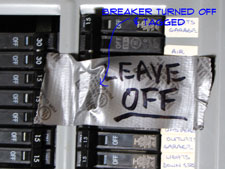 Safety standards for large buildings and construction projects call for a 'lock out - tag out' procedure to be in place whenever something the could cause physical harm. When electrical circuits are worked on, they need to be locked off and tagged to let anyone who has access to the panel know that the circuit is being worked on.
Safety standards for large buildings and construction projects call for a 'lock out - tag out' procedure to be in place whenever something the could cause physical harm. When electrical circuits are worked on, they need to be locked off and tagged to let anyone who has access to the panel know that the circuit is being worked on.
In a home, these restrictive protocols are not in place. However, a safety conscious person will want to take similar precautions. Shutting off a breaker is not enough, some sort of restriction and identification should be put on the breaker to let anyone know that the circuit is being worked on. OSHA has guidelines on this, however, every situation is different and it is the responsibility of the person or contractor doing the work to make sure safety precautions are followed.
This is no laughing matter, the current that goes to a water heater can kill you. Take steps to prevent the breaker from being inadvertently turned on.
This is another safety precaution. Use some tape over the turned off breaker at the panel. Mark on it, 'Do Not Turn On' in magic marker on the tape. This will stop someone from inadvertently turning the power back on while you are working on it.
Step Three - Cooling the Hot Water
For many repairs, you are going to want to cool off the water before you attempt to work on the tank. With the power off, the water will no longer be heated, even when the temperature drops.
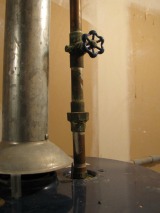 To cool the water temperature off, turn on a hot faucet in one of the sinks, do not add any cold water to it, let it run full hot. Let the water run until it feels luke warm. If the water coming out is warm to the touch it will be safe for working on the tank.
To cool the water temperature off, turn on a hot faucet in one of the sinks, do not add any cold water to it, let it run full hot. Let the water run until it feels luke warm. If the water coming out is warm to the touch it will be safe for working on the tank.
When you turn the hot water heater back on, it will take the normal recovery time for the water to heat back up. So give the tank an hour or so before you try to use it for anything that needs hot water, such as a shower or laundry.
Step Four - Shutting Off the Water
A properly installed hot water tank should not have a shut off valve on the hot water outlet side. This will prevent the tank from building up too much internal pressure. Shutting off the cold supply, is all that is needed when working on your hot water tank.
If you have two valves above your water heater, you will need to determine which one is the cold supply line. As you face the front of the tank, it should be the valve on the right side. This may not be fool proof, since the extra valve should not be there.
If you run some hot water, you can feel the pipes. The cold water supply line will be cool or cold. The hot water inlet will be warm after you run hot water through it.
Turn on the hot water in a faucet. You can tell by feeling the pipes, which one is the hot and cold. Tag the cold water valve so that you know which one it is to shut off. Wait until you have cooled the water down inside the tank to shut the water off.
Step Five - Draining a Hot Water Tank
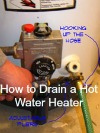 Some activities on an electric water heater can be done without draining the tank. Checking and testing the elements and thermostats can be done with the tank full. Adjusting and replacing the thermostats can also be done with the tank full. You can also check the power supply to the unit without draining it.
Some activities on an electric water heater can be done without draining the tank. Checking and testing the elements and thermostats can be done with the tank full. Adjusting and replacing the thermostats can also be done with the tank full. You can also check the power supply to the unit without draining it.
Replacing or removing the elements for any reason cannot be done with the tank full. You will have to cool the water and drain the tank before you can work on the elements.
You need to drain the tank if you are going to flush the sediment out. Regularly flushing sediment is important on electric water heaters. Sediment build up will damage the lower heating element, dramatically reducing the amount of hot water you will have.
This is a bit of a job in itself. See the article, 'Draining a Hot Water Heater', for information and instructions on how to empty the tank.
Where To Next?
After you have completed your repairs you are going to need to get your water heater working again. See the article, 'Starting Up a Hot Water Heater' for instructions. The steps are similar to shutting a water heater down, you just want to get them in the right order.

